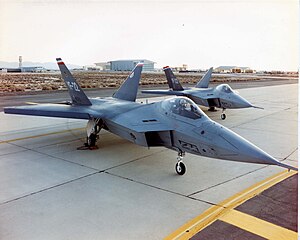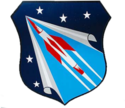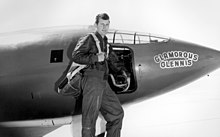Air Force Systems Command
| Air Force Systems Command | |
|---|---|
 Lockheed-Boeing-General Dynamics YF-22 Advanced Tactical Fighters, 1990. The YF-22 was the last major weapons system delivered to Air Force Systems Command prior to its inactivation and merger into Air Force Materiel Command. | |
| Active | 1 February 1950 – 1 July 1992 |
| Country | |
| Branch | |
| Type | Major Command |
| Garrison/HQ | Baltimore, Maryland (1950–1958) Andrews Air Force Base, Maryland (1958–92) |
| Nickname(s) | AFSC |
| Insignia | |
| Emblem of Air Force Systems Command (1961–1992) |  |
| Emblem of Air Research and Development Command (1950–1961) |  |
The Air Force Systems Command (AFSC) is an inactive
Overview
AFSC took on engineering functions which formerly resided in the Air Materiel Command (AMC), the Army Air Forces Technical Service Command (TSC), and the Air Technical Service Command (ATSC) as a separate research and development command in 1950. It incorporated
In the reorganization of 1961, Air Force Systems Command acquired the materiel procurement function from
History
Origins
The origins of Air Force Systems Command date at least to the establishment of the Airplane Engineering Department by the Chief Signal Officer, U.S. Army, on 13 October 1917 at
American aviation development fell behind its European rivals after the mid-1930s when Germany started a continental arms race. The threat of war at the decade's end began to change the situation. During the late 1930s American industry spent over $100 million annually on aviation research. University grants grew and military personnel enrollment in science courses increased. Leaders of the

The war had shown the destructiveness of aerial attack and made Arnold an aggressive advocate for aeronautical research. On 7 November 1944, General Henry H. "Hap" Arnold, Commanding General of the Army Air Forces, directed the AAF Scientific Advisory Group (SAG) to study the technological achievements of America's wartime allies and provide a blueprint for large-scale research and development of science and advanced technology for the Air Force.[2]
However, the Army Air Forces needed to achieve independence, which it did on 18 September 1947, with its transition into an independent
Cold War


Research and Development Command was redesignated the
During the 1950s, the new command began to make its mark. ARDC developed many ambitious aircraft and missile prototypes. Among the successes of this period were the North American F-86 Sabre swept wing fighter, the Boeing B-52 Stratofortress intercontinental bomber, the Boeing KC-135 Stratotanker jet-powered refueling tanker aircraft, the Lockheed C-130 Hercules turboprop transport and the Lockheed U-2 very high-altitude strategic reconnaissance aircraft. In addition, ARDC played a major contribution in the development of Intercontinental ballistic missiles (ICBMs), which became a priority after the world learned that the Soviet Union had detonated a thermonuclear (hydrogen) bomb on 23 August 1953. A crash program was employed which developed America's first ICBM (the SM-65D Atlas), that became operational in 1959. In terms of importance, resources, and success, the ICBM program was rivaled only by the famed Manhattan Project of World War II.[2]

The Atlas program led to the belief that the entire responsibility for deploying new weapons systems – from research, development and testing through procurement and production – should be vested in one command, rather than split between Air Materiel Command (AMC) and ARDC. It was the
Under the
Vietnam era and aftermath

As the
The sustained growth of Soviet power after the Cuban Missile Crisis challenged the entire spectrum of U.S. military capabilities. These factors led to a new wave of Air Force weapons development beginning in the late 1960s. Systems Command found itself managing a broad array of new tactical and strategic programs including the McDonnell Douglas F-15 Eagle, General Dynamics F-16 Fighting Falcon fighters, the Fairchild Republic A-10 Thunderbolt II ground support aircraft, the LGM-118 Peacekeeper, the AGM-86 (air) and BGM-109 (ground) cruise missiles, the Boeing E-3 Sentry Airborne Warning and Control System, the Boeing C-17 Globemaster III transport, the Rockwell B-1 Lancer bomber, and a new generation of orbiting Reconnaissance satellites. These programs were the main activities of AFSC during the 1970s.[2]
With the
During this turbulent period, new and updated weapons systems continued to join the USAF. The B-1B Lancer was delivered to SAC in record time, though with significant problems that would hamper its service career for some time.
Inactivation
With the 1992 reorganization of the Air Force, the functions of AFSC and
Lineage
- Established as Research and Development Command on 23 January 1950[1]
- Organized as a major command on 1 February 1950
- Re-designated: Air Research and Development Command on 16 September 1950
- Re-designated: Air Force Systems Command on 1 April 1961
- Inactivated on 1 July 1992.
Assignments
- Air Materiel Command, 23 January 1950[1]
- United States Air Force, 1 February 1950 – 1 July 1992
Stations
- Baltimore, Maryland, 23 January 1950[1]
- Andrews Air Force Base, Maryland, 24 January 1958 – 1 July 1992.
Command bases and major units
|
|
Commanders of Air Force Systems Command
| No. | Image | Name | Tenure | Notes |
|---|---|---|---|---|
| 1 | 
|
Gen. Bernard A. Schriever
|
1961–1966 | |
| 2 | 
|
Gen. James Ferguson | 1966–1970 | |
| 3 | 
|
Gen. George S. Brown | 1970–1973 |
|
| 4 | 
|
Gen. Samuel C. Phillips | 1973–1975 |
|
| 5 | 
|
Gen. William J. Evans | 1975–1977 |
|
| 6 | 
|
Gen. Lew Allen | 1977–1978 |
|
| 7 | 
|
Gen. Alton D. Slay | 1978–1981 | |
| 8 | 
|
Gen. Robert T. Marsh | 1981–1984 | |
| 9 | 
|
Gen. Lawrence A. Skantze | 1984–1987 | |
| 10 | 
|
Gen. Bernard P. Randolph | 1987–1990 | |
| 11 | 
|
Gen. Ronald W. Yates | 1990–1992 |
|
References
![]() This article incorporates public domain material from the Air Force Historical Research Agency
This article incorporates public domain material from the Air Force Historical Research Agency
- ^ a b c d e f g "Air Force Systems Command Factsheet". Archived from the original on 19 February 2013. Retrieved 14 August 2012.
- ^ a b c d e f g h i j k l m Air Force Systems Command, Delivering The Future (1989). Compiled by Lt. Col. Beverly S. Follis, USAFR HQ AFSC/Office of History
- ^ "Shelbyville Times-Gazette: Local News: AEDC assisted shuttle's return to flight (07/13/05)". Shelbyville Times-Gazette. Retrieved 5 March 2015.
- LCCN 73601243.
- ISBN 978-1849088404.
- ^ World Air Power Journal
- ^ "AFHRA Air Force Systems Command". Archived from the original on 19 February 2013. Retrieved 14 August 2012.
- ISBN 0-16-002261-4
